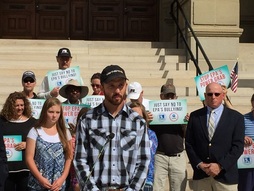 Trump signs bill to cut back EPA regulations. Trump signs bill to cut back EPA regulations.
9 Desks Emptied In The EPA As President Trump Follows Through On His Promise
Posted by Allison Hillman | May 8, 2017 President Trump has told America time and again, he intends to clean house. So it is puzzling that liberals are still whining when he does that very thing. Perhaps they are just not used to having leaders who follow through on promises. Scott Pruitt, the administrator for the Environmental Protection Agency, has been targeted today for his role in helping the president cut the fat from the liberal, money-wasting agency. The EPA announced they would be letting nine of the 18 members of the Board of Scientific Counselors go. The group of employees was notified that their terms would not be reviewed or as Robert Richardson, one of those fired, put it, “Today, I was Trumped.” EPA spokesman J.P. Freire told reporters that being fired is not the correct terminology in this case. “It’s not a dismissal. It’s simply the end of the term. We’re opening up a process. We’re actually setting up our system so we can attract applicants who are highly qualified and ensure we have the best people on this board as possible and that’s why we’re inviting people currently sitting on the board to reapply as well.” The EPA did an amazing amount of work during Obama’s terms, unfortunately, most of it was useless and costly. The board’s job is to review data that the agency uses to make rules. Sometimes the board is made up of representatives from private industry. During Obama’s years, it was generally comprised of academics. Pruitt has continually tried to reassure the public that the EPA will not suddenly disregard scientific research. However, the agency has made headlines lately for ridiculous and costly studies that contribute nothing towards science or protecting the American people. Perhaps ignoring some of that research would be beneficial. President Trump and his administration have made it quite clear, they will not allow the citizens to be fleeced by an overspending government any longer. Of course, listening to DNC Chair Tom Perez, the president is the bad guy here. “There’s a name for Donald Trump’s environmental policy: aggressive stupidity. The scientists he just fired have been working on nothing more political than making sure our water is safe to drink and our air is safe to breathe. By turning them into political targets, Trump is proving yet again that he doesn’t care about ordinary people.” ___________________________ 
WYOMING RANCHER BEATS EPA IN POND FIGHT
$16 million in fines dropped, threats canceled Published: 18 hours ago Wyoming rancher Andy Johnson talks about his lawsuit against EPA, in news conference in Cheyenne (Photo courtesy Pacific Justice Foundation) A Wyoming rancher threatened by the Environmental Agency with $16 million fines for getting a state permit and building a stock pond on his ranch has reached a settlement that will have the fines go away and he’ll keep his stock pond. WND reported in 2015 on a lawsuit filed on behalf of Fort Bridger, Wyoming, rancher Andy Johnson by officialsl with the Pacific Legal Foundation seeking to vindicate his property rights. The lawsuit explained federal law clearly exempts stock ponds from the rules of the EPA, which had filed a compliance order against him threatening $37,500 in fines per day – which already at the time of the filing had passed $16 million. Now, officials the PLF has announced the federal government has agreed to resolve the case, and a federal court has approved. “Importantly, under the settlement, the Johnson family’s pond will remain; they won’t pay any fines; they don’t concede any federal jurisdiction to regulate their pond; and the government won’t pursue any further enforcement actions based on the pond’s construction,” the legal team revealed. Trust the government? Maybe you shouldn’t. Read the details in “Lies the Government Told You,” by Judge Andrew Napolitano. “This is a victory for common sense and the environment, and it brings an end to all the uncertainty and fear that the Johnson family faced,” said Jonathan Wood, a staff attorney with Pacific Legal Foundation. The fight began in 2013 when Johnson, under a legitimate state permit, built the stock pond to provide safer, more reliable access to water for his small herd. Ray Kagel, a former federal regulator, explained how the pond proved to be a benefit to the environment. It created wetlands, habitat for fish and wildlife, and cleans the water that passes through it. The federal government responded with its threats of fines. Johnson tried to reason with the government, without success, so he filed the action that points out “stock ponds” are expressly exempted from the Clean Water Act. “This settlement is a win for the Johnson family, and a win for the environment,” said Wood. “Under it, the Johnsons will pay no fine. They will not lose their property. They will not have to agree to federal jurisdiction or a federal permit, which would have surely entailed onerous conditions. In effect, the government will treat the pond as an exempt stock pond, in exchange for Andy further improving on the environmental benefits he has already created. “The settlement provides that Andy will plant willows around the pond and temporarily fence off part of it from livestock. Of course, there is some irony in this last provision: The EPA insists this isn’t a stock pond, while their chief concern is how livestock reach it.” Andy Johnson built a “stock pond” to provide better access to water for animals on his ranch. Johnson, in a statement released by PLF, said, “This is a huge victory for us as well as private property owners across the country. The next family that finds itself in our situation, facing ominous threats from EPA, can take heart in knowing that many of these threats will not come to pass. If, like us, you stand up to the overreaching bureaucrats, they may very well back down.” Trust the government? Maybe you shouldn’t. Read the details in “Lies the Government Told You,” by Judge Andrew Napolitano. Read more at ____________________________ |

THE TRUTH ABOUT EPA’S COSTLY CARBON REGULATIONS
Low-cost, reliable electricity from coal powers households and businesses across America but regulations from the Environmental Protection Agency jeopardize our access to affordable power and will cause electricity prices to skyrocket. New analysis from NERA Economic Consulting reveals significant negative economic impacts resulting from EPA’s carbon emissions regulations, as the costs to comply with the plan could total nearly $300 billion from 2022 to 2033. Consumers will ultimately foot the bill for these rising costs, which include double-digit electricity price increases in 41 states, with 28 states potentially facing peak year electricity price increases of at least 20 percent. Check out the analysis to see just how devastating EPA’s plan is for America’s consumers and businesses.Download the Analysis Sign Up to Stay Informed By the Numbers: The Real Impacts of EPA’s Clean Power Plan NERA’s new analysis projects that EPA’s Clean Power Plan will cost consumers and businesses as much as $39 billion a year, far outpacing the costs of compliance for all EPA rules for power plants in 2010 ($7 billion) and the annual cost of the Mercury and Air Toxics Standards rule ($10 billion). The analysis also finds that additional coal retirements would total up to 47,000 megawatts or more of coal-based electricity, posing a major threat to electric reliability in many parts of the country. Despite these significant impacts, EPA’s illegal rule will have virtually no effect on climate change, reducing atmospheric CO2 concentration by less than one-half of a percent, lowering global average temperature by 2/100th of a degree, and reducing sea level rise by the thickness of two sheets of paper. What Does EPA's Plan Mean to Your Home State? 
Electric cooperatives challenged by Clean Power Plan By Tom Lutey / Billings Gazette on Jan 27, 2016 at 9:57 p.m. BILLINGS, Mont. -- Electric cooperatives will likely share in a $5 billion bill to comply with the federal Clean Power Plan, officials said recently.The $5 billion is what Basin Electric Power Cooperative estimates it will need to cut greenhouse gases from its coal-fired power plants while also adding wind farms and gas-fired generators as replacement energy sources. “These billions of dollars would simply cover adding new generation and potentially impact the operations of our existing facilities," said Mary Miller, Basin Electric communications director. "This does not even include the expense of additional electric or gas infrastructure.” North Dakota-based Basin Electric is collectively owned by 140 rural electric cooperatives, including 14 in Montana stretching across the state from Kalispell to Sidney. Those cooperatives easily have more than 100,000 ratepayers, mostly households. One shareholder, Yellowstone Valley Electric Cooperative, has 19,000 customers in the Billings region. The Clean Power Plan is the Environmental Protection Agency’s 15-year roadmap for cutting carbon dioxide, a greenhouse gas that contributes to climate change. Beginning in 2020, the nation’s existing power plant will have to begin cutting carbon dioxide pollution. Some power plants will be upgraded with new pollution controls, while others beyond improvement will be shuttered. States are required to submit compliance plans to the EPA by September. Extensions may be granted, but federal plans could also be issues in areas where plans aren’t submitted. Basin Electric’s situation is complicated, said Gary Wiens of the Montana Electric Cooperatives’ Association. Basin has power generating facilities in six different states. Each state needs its own strategy for complying with the Clean Power Plan. “We know it will mean some kind of a cost increase, but we don’t know the numbers yet,” Wiens said. Coal power is about half of Basin’s supply. The cooperative also has 1,000 megawatts of wind, and gas-fired power plants, including one in Culbertson. In recent years, Basin has invested $1.4 billion in wind farms and gas plants, said Brandon Wittman, CEO of Yellowstone Valley Electric Cooperative. Basin subsidiary, the Dakota Gasification Company runs the Great Plains Synfuels Plant, which is the world’s largest carbon capture and sequestration project — capturing more than 30 million tons of carbon dioxide. A federal tax credit on wind-generated power made the wind turbines a logical step, Wittman said. He said he’s frustrated that the carbon capture facility won’t be counted by EPA in Basin’s compliance column because it already exists. Another $1.4 billion has been spent on upgrading Basin’s coal facilities. If Basin had to upgrade tomorrow, Wittman said Yellowstone Electric Cooperative customers would see a 50 percent increase in their utility bills. He considers tougher carbon pollution standards inevitable, but said Basin can’t comply fast enough. “We need a more negotiated approach,” Wittman said. “You can’t take down all the coal power in the country, which is essentially what this is going to do.” Not all coal power plants will be shuttered, Basin’s Mary Miller clarified. Basin newest coal-fired power plant, the Dry Fork Station in Gillette, Wyo., came online in 2011. That coal power plant and others in Basin’s quiver, aren’t vulnerable to shut down, though some facilities are. Miller said it’s ironic that the Basin’s coal-fired power plants are now scrutinized considering it was the federal government that pushed Basin into coal 40 years ago when there were national concerns about a future natural gas shortage. The nation is now flush with natural gas because of the hydraulic fracturing of horizontal oil and gas wells. “The bulk of our generation was built during the Fuel Use Act of 1978, when we were prohibited from building natural gas base-load facilities,” Miller said. “Despite our investing billions of dollars to maintain and make these units some of the cleanest in the country, now the EPA is essentially telling us to do the opposite — shut down coal and build wind, which needs to be backed up by peaking generation — gas.” Basin is working with states to comply with the Clean Power Plan, Miller said. However, it is also suing EPA over the legality of the Clean Power Plan. |
 PHOTO: GETTY IMAGES/ISTOCKPHOTO PHOTO: GETTY IMAGES/ISTOCKPHOTO
A Step Toward Scientific Integrity at the EPA
Scott Pruitt sweeps out Obama-era science advisers. The agency needs truly independent ones. By Steve Milloy July 17, 2017 5:14 p.m. ET The Trump administration in May began the process of replacing the small army of outside science advisers at the Environmental Protection Agency. In June, 38 additional EPA advisers were notified that their appointments would not be renewed in August. To Mr. Trump’s critics, this is another manifestation of his administration’s “war on science.” Histrionics aside, the administration’s actions are long overdue. The most prominent of the EPA’s myriad boards of outside advisers are the Science Advisory Board and the Clean Air Scientific Advisory Committee, or CASAC. Mostly made up of university professors, these boards also frequently draw members from consulting firms and activist groups. Only rarely do members have backgrounds in industry. All EPA boards are governed by the Federal Advisory Committee Act, which requires that they be balanced and unbiased. While the EPA is required by law to convene the SAB and CASAC, the agency is not bound by law to heed their advice. The EPA’s Obama -era “war on coal” rules and its standards for ground-level ozone—possibly the most expensive EPA rule ever issued—depend on the same scientifically unsupported notion that the fine particles of soot emitted by smokestacks and tailpipes are lethal. The EPA claims that such particles kill hundreds of thousands of Americans annually. The EPA first considered regulating fine particles in the mid-1990s. But when the agency ran its claims past CASAC in 1996, the board concluded that the scientific evidence did not support the agency’s regulatory conclusion. Ignoring the panel’s advice, the EPA’s leadership chose to regulate fine particles anyway, and resolved to figure out a way to avoid future troublesome opposition from CASAC. In 1996 two-thirds of the CASAC panel had no financial connection to the EPA. By the mid-2000s, the agency had entirely flipped the composition of the advisory board so two-thirds of its members were agency grantees. Lo and behold, CASAC suddenly agreed with the EPA’s leadership that fine particulates in outdoor air kill. During the Obama years, the EPA packed the CASAC panel. Twenty-four of its 26 members are now agency grantees, with some listed as principal investigators on EPA research grants worth more than $220 million. Although the scientific case against particulate matter hasn’t improved since the 1990s, the EPA has tightened its grip on CASAC. In effect, EPA-funded researchers are empowered to review and approve their own work in order to rubber-stamp the EPA’s regulatory agenda. This is all done under the guise of “independence.” Another “independent” CASAC committee conducted the most recent review of the Obama EPA’s ground-level ozone standards. Of that panel’s 20 members, 70% were EPA grantees who’d hauled inmore than $192 million from the agency over the years. These EPA panels make decisions by consensus, which has lately been easy enough to achieve considering they are usually chaired by an EPA grantee. Would-be reformers have so far had no luck changing the culture at these EPA advisory committees. In 2016 the Energy and Environment Legal Institute, where I am a senior fellow, sued the agency. We alleged that the CASAC fine-particulate subcommittee was biased—a clear violation of the Federal Advisory Committee Act. We found a plaintiff who had been refused CASAC membership because of his beliefs about fine particles. Unfortunately, that individual was not willing to take a hostile public stand against the EPA for fear of professional retribution. We ultimately withdrew the suit. The EPA’s opaque selection process for membership on its advisory boards has opened the agency to charges of bias. In 2016 Michael Honeycutt, chief toxicologist of the Texas Commission on Environmental Quality, was recommended in 60 of the 83 nominations to the EPA for CASAC membership. The EPA instead selected Donna Kenski of the Lake Michigan Air Directors Consortium. Ms. Kenski received only one of the 83 recommendations. While no one objected to Mr. Honeycutt’s nomination, Sen. James Inhofe (R., Okla.) lodged an objection to Ms. Kenski’s nomination, claiming she had exhibited partisanship during an earlier term on the committee. Congress has also tried to reform the EPA’s science advisory process. During the three most recent Congresses, the House has passed bills to provide explicit conflict-of-interest rules for EPA science advisers, including bans on receiving EPA grants for three years before and after service on an advisory panel. The bills went nowhere in the Senate, where the threat of a Democrat-led filibuster loomed. Had they passed, President Obama surely would have vetoed them. President Trump and his EPA administrator have ample statutory authority to rectify the problem. As Oklahoma’s attorney general, Scott Pruitt spent years familiarizing himself with the EPA’s unlawful ways. He is in the process of reaffirming the independence of the agency’s science advisory committees. This won’t mean that committee members can’t have a point of view. But a committee as a whole must be balanced and unbiased. Mr. Pruitt’s goal is the one intended by Congress—peer review, not pal review. Mr. Milloy served on the Trump EPA transition team and is the author of “Scare Pollution: Why and How to Fix the EPA.” Appeared in the July 18, 2017, print edition. __________________________ 
Help Abolish the EPA by Supporting H.R. 861 On February 3, 2017, freshman Congressman Matt Gaetz (R-Fl.) introduced H.R. 861, a bill to abolish the Environmental Protection Agency (also known as the EPA). Representative Gaetz's bill, which is only one sentence long, states, "The Environmental Protection Agency shall terminate on December 31, 2018." On a video posted on his Facebook page, Congressman Gaetz explained, "For six years in the [Florida state] legislature, I had a front row seat to the failures of the federal government in protecting the environment." Gaetz continued, "The question isn't whether to protect the environment. The question is who is better equipped to actually do that?" Gaetz further explained that his bill wouldn't affect the 1963 Clean Air Act or the 1972 Clean Water Act. Instead, such responsibilities would return to the states and local communities to address. "The Clean Air Act and the Clean Water Act, they would stay in effect after my bill, but enforcement of those laws would fall to state and local governments," Gaetz said and further adding, "local communities tend to be able to react a lot quicker." To learn more about Gaetz's bill click here. Among the bill's original cosponsors, Congressman Thomas Massie (R-Ky.) said about his support of the bill, "The Constitution reserves lawmaking authority for the legislative branch not unelected bureaucrats in the executive branch." Massie added, "The EPA makes rules that undermine the voice of the American people and threaten jobs in Kentucky." In addition to Massie, the original cosponsors of Gaetz's bill include Congressman Barry Loudermilk (R-Ga.) and Congressman Steven M. Palazzo (R-Miss.). Although Gaetz's bill does not specifically address the many unconstitutional federal laws related to the environment that have been passed either prior to or since the EPA was created, the bill is certainly an encouraging first step in the right direction toward removing the federal government from environmental policy. If passed by Congress and signed by President Trump, Gaetz's bill would help return the power of environmental policy rightfully back to the states, local communities, and the people, and help turn the tide on the extreme environmental movement that has used the EPA as a catalyst to impose its radical anti-property rights and anti-free market agendas. Please phone your representative (202-225-3121) and senators (202-224-3121) and ask your representative to cosponsor and support passage of H.R. 861, a bill to abolish the unconstitutional Environmental Protection Agency, and ask your senators to introduce and cosponsor a companion bill in the Senate. Let them know that you support private property rights and want to prevent the federal government from passing laws and creating regulations regarding the environment and to return such power back to the states, local communities, and the people by abolishing the unconstitutional EPA. Please email the same message to your congressman. Thanks. Your Friends at The John Birch Society ___________________________ Smoke and Mirrors: Obama's COP 21 Rhetoric
Published on Nov 24, 2015
Don’t be fooled by President Obama’s rhetoric in Paris during COP 21 - it's all smoke and mirrors. While touting his plan to the international community, in the U.S. his carbon plan is widely opposed and far from a done deal. Learn more at www.AmericasPower.org. |

